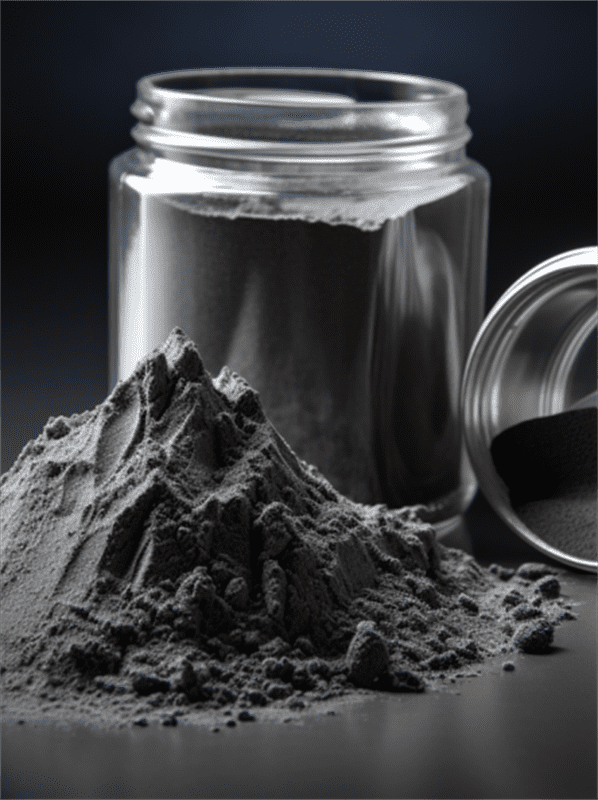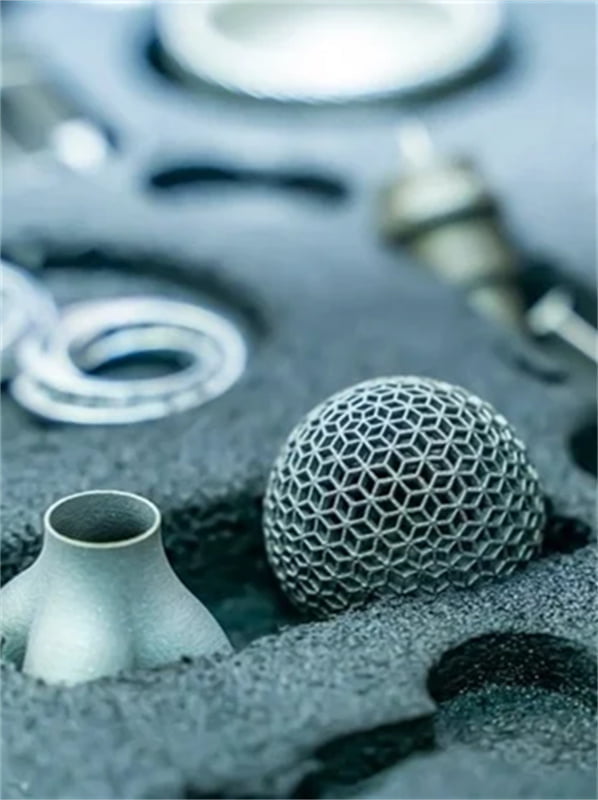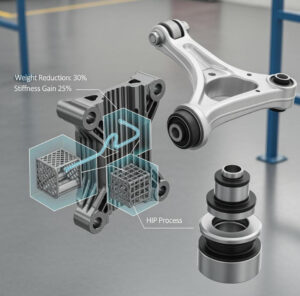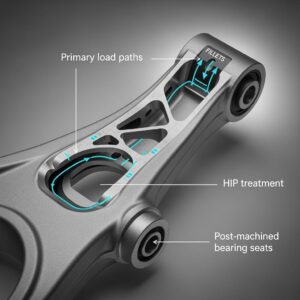Atomizované kovy: Atomizované kovy: typy, charakteristiky, specifikace
Obsah
Přehled
Atomizované kovy se vztahují na kovové prášky vyráběné atomizací, což je proces, při kterém se roztavený kov rozbije na jemné kapičky a rychle se ochladí, čímž vznikne prášek. Proces atomizace umožňuje přesnou kontrolu velikosti částic, morfologie a mikrostruktury prášku.
Atomizované kovové prášky se používají v široké škále aplikací včetně výroby, 3D tisku a povrchových úprav. Poskytují výhody, jako je vysoká čistota, konzistence a možnost vývoje speciálních slitin. Mezi nejčastěji atomizované kovy patří hliník, měď, železo, nikl a titan.
Tato příručka poskytuje podrobný přehled o atomizovaných kovových prášcích, který zahrnuje typy, vlastnosti, aplikace, specifikace, dodavatele, instalaci, provoz, údržbu a další informace. Jejím cílem je pomoci čtenářům porozumět této technologii a informovaně se rozhodovat při výběru atomizovaných kovových prášků.
Typy atomizovaných kovů
Existují dva hlavní typy atomizovaných kovových prášků:
Kovy atomizované vzduchem
Při vzduchové atomizaci se proud roztaveného kovu rozbíjí na kapičky pomocí vysokotlakého vzduchu nebo inertního plynu. Prášky atomizované vzduchem mají kulovitou morfologii s hladkým povrchem. Jsou vhodné pro aplikace vyžadující dobrou tekutost.
Kovy atomizované vodou
Při vodní atomizaci se roztavený kov rozkládá vysokotlakými vodními proudy. Vodou atomizované prášky mají nepravidelný tvar s drsnou povrchovou strukturou. Poskytují vyšší stlačitelnost, která je výhodná pro lisovací aplikace.
Níže uvedená tabulka shrnuje hlavní rozdíly mezi kovovými prášky rozprašovanými vzduchem a vodou:
| Parametr | Rozprašovaný vzduch | Atomizovaná voda |
|---|---|---|
| Tvar částice | Sférické | Nepravidelné, zubaté |
| Textura povrchu | Hladký | Hrubý |
| Tekutost | Vynikající | Mírný |
| Zdánlivá hustota | 2 - 3,5 g/cc | 3 - 4 g/cc |
| Stlačitelnost | Mírný | Vysoký |
| Rychlost výroby | Dolní | Vyšší |
| Náklady | Vyšší | Dolní |

Charakteristiky atomizovaných kovových prášků
Mezi hlavní charakteristiky určující kvalitu a výkonnost atomizovaných kovových prášků patří:
Velikost částic - Rozložení velikosti částic určuje hustotu balení, tekutost a povrch. Přísnější kontrola velikosti vede k lepší konzistenci produktu.
Morfologie - Tvar částic ovlivňuje hustotu, zhutnění a spékání. Kulovité částice mají lepší tok, zatímco nepravidelné tvary poskytují vyšší pevnost v zeleném stavu.
Čistota - Pro kritické aplikace je nezbytná vysoká čistota. Nečistoty lze minimalizovat použitím surovin s nízkou kontaminací.
Obsah kyslíku - Nižší obsah kyslíku snižuje reaktivitu prášku a zlepšuje konečné vlastnosti materiálu. Prášky rozprašované vodou mají tendenci k vyššímu příjmu kyslíku.
Zdánlivá hustota - Vyšší hustota znamená lepší průtok a efektivitu manipulace. Typické hodnoty se pohybují od 25% do 60% teoretické hustoty.
Tekutost - Dobrý tok prášku zajišťuje spolehlivost automatizovaných procesů tvarování, plnění a balení. Závisí na parametrech, jako je velikost částic, tvar a drsnost povrchu.
Stlačitelnost - Stlačitelnost určuje pevnost lisovaného dílu v zeleném stavu před spékáním. Nepravidelný tvar částic zlepšuje vzájemné propojení a pevnost zelené hmoty.
Pečlivá kontrola těchto vlastností prášku v procesu atomizace je zásadní pro dosažení opakovatelného vysokého výkonu.
Aplikace atomizovaných kovových prášků
Rozprašované kovové prášky se používají v široké škále průmyslových odvětví a aplikací s využitím jejich jedinečných výhod. Mezi hlavní oblasti použití patří:
Aditivní výroba kovů
Tento způsob tisku, známý také jako 3D tisk kovů, spočívá ve vytváření kovových součástí po vrstvách z práškového materiálu. Preferují se jemné sférické prášky s řízenou distribucí velikosti pro hladký tok a balení při roztírání. Mezi běžné materiály patří titan, hliník, niklové slitiny a nástrojové oceli.
Prášková metalurgie
Rozprašované prášky se stlačují za vysokých tlaků do "zelených" dílů a poté se spékají, aby se vyrobily hotové součásti. Nepravidelně tvarované částice prášku mají lepší stlačitelnost. Součástky se složitou geometrií lze vyrábět téměř v čistém tvaru, čímž se minimalizuje materiálový odpad.
Povrchové nátěry
Techniky termického stříkání, jako je plazmové stříkání, nanášejí roztavené nebo polotavené prášky na povrchy a vytvářejí ochranné nebo funkční povlaky. Jemnější sférické prášky zvyšují hustotu povlaku a pevnost spoje. Běžně se používají povlaky odolné proti opotřebení a korozi.
Vstřikování kovů (MIM)
Jedná se o kombinaci vstřikování plastů a práškové metalurgie pro výrobu malých, složitých kovových dílů ve tvaru sítě. Pro bezchybné plnění forem jsou vyžadovány hladce tekoucí prášky s přizpůsobenou velikostí částic a pojivy.
Pájení a pájení
Předlisky z atomizovaného prášku umožňují metalurgické spojování složitých součástí. Hladké prášky s kontrolovanou velikostí zajišťují optimální výrobu předforem. Mezi plniva pro pájení patří hliník, stříbro a měď.
Třecí materiály
Rozprašované kovové prášky slouží jako modifikátory tření v brzdových destičkách a dalších aplikacích. Přídavky mědi, železa a mosazi v prášku zlepšují tření a odolnost proti opotřebení ve srovnání s organickými přípravky bez azbestu.
Specifikace atomizovaných kovových prášků
Atomizované kovové prášky musí splňovat náročné specifikace přizpůsobené výrobnímu procesu a požadavkům na konečné použití. Typické specifikace prášků jsou uvedeny níže:
Distribuce velikosti částic
| Parametr | Typický rozsah |
|---|---|
| D10 | 10 - 45 μm |
| D50 | 20 - 75 μm |
| D90 | 40 - 150 μm |
D10, D50 a D90 označují velikost částic prášku, pod kterou se nachází 10%, 50% a 90% vzorku. Těsnější distribuce zlepšuje hustotu a výkon.
Morfologie
- Tvar - kulovitý, nepravidelný
- Textura povrchu - hladká, drsná
- Satelity - Méně než 5% hmotnosti
Čistota
- Kyslík - <1000 ppm
- Dusík - <100 ppm
- Uhlík - <1000 ppm
- Ostatní nečistoty - specifické pro daný prvek
Zdánlivá hustota
- Hustota prášku - obvykle 40-60% teoretické hustoty
- Hustota lití - 25-40% teoretické hustoty
Dodržení specifikací prášku je zásadní pro opakovatelné zpracování a kvalitu konečného výrobku. Renomovaní dodavatelé poskytují komplexní analytické certifikáty.
Dodavatelé atomizovaných kovových prášků
Mnoho společností se specializuje na výrobu atomizovaných kovových prášků pro různé aplikace. Mezi přední světové dodavatele patří:
Atomising Systems Limited
- Centrála - Sheffield, Velká Británie
- Materiály - Al, Cu, Fe, Ni
- Kapacita - 4000 tun/rok
- Obsluha trhů s AM, tepelným nástřikem
Sandvik Osprey
- Centrála - Neath, Velká Británie
- Materiály - Ti, Al, oceli, superslitiny
- Kapacita - 14 000 tun/rok
- Rozsáhlé portfolio pro průmysl AM
Höganäs AB
- Sídlo společnosti - Höganäs, Švédsko
- Materiály - slitiny Fe, Cu, Al
- Kapacita - 300 000 tun/rok
- Zaměření na automobilový průmysl
Práškové kovy ATI
- Centrála - Pittsburgh, USA
- Materiály - slitiny Ti, Ni, Al, Fe
- Kapacita - 15 000 tun/rok
- Přední dodavatel pro aditivní výrobu
Materiály Mitsubishi
- Centrála - Tokio, Japonsko
- Materiály - Cu, Ni, cementované karbidy
- Kapacita - 8000 tun/rok
- Silné zastoupení na asijských trzích
Ceny se značně liší v závislosti na materiálu, čistotě, velikosti částic a objemu nákupu. U běžných kovů počítejte s cenou $20-100 za kg a u speciálních slitin $100-500 za kg.

Instalace systémů atomizovaného kovového prášku
Instalace zařízení pro manipulaci s rozprašovanými kovovými prášky vyžaduje pozornost věnovanou bezpečnosti, čistotě a spolehlivosti. Zde je několik klíčových úvah:
Uzavření
- Pro skladování a přepravu používejte uzavřené nádoby
- Minimalizace manipulace na volném prostranství prostřednictvím uzavřených dopravníků a přesunů
- Integrace rukavicových boxů, digestoří RTP pro manuální operace
- Odsávání prachu pomocí sáčkových nebo cyklónových filtrů
Prevence výbuchu
- Zajistěte, aby byla elektrická zařízení řádně uzemněna a spojena.
- Instalace systémů pro detekci a potlačení jisker
- Vyhněte se potenciálním zdrojům vznícení v nebezpečných oblastech.
Čistota
- Systém by měl mít hladký vnitřní povrch pro snadné čištění.
- V případě potřeby zahrňte opatření pro proplachování inertním plynem.
- Zavedení postupů pro běžné čištění a údržbu
Manipulace s materiálem
- Výběr zařízení kompatibilního s vlastnostmi toku prášku
- Zvažte vibrační podavače, rotační ventily, vakuovou dopravu.
- Zajistěte optimální tok prášku bez krysích stop a přemostění.
Správná instalace podle doporučení dodavatele je klíčem k maximalizaci účinnosti a bezpečnosti zařízení.
Provoz systémů atomizovaného kovového prášku
Efektivní provoz systémů pro manipulaci s kovovým práškem vyžaduje školení personálu o postupech a bezpečných praktikách. Mezi klíčové aspekty patří:
- Používejte vhodné osobní ochranné prostředky - respirátory, rukavice, ochranné brýle.
- Zamezte rozsypání prášku a minimalizujte prašnost.
- Neotevírejte zařízení pod zatížením
- Před údržbovými zásahy dodržujte postup proplachování
- Provádění pravidelných inspekcí a kontrol těsnosti
- Udržování optimálního průtoku a přednastavených tlaků/vakuí
- V případě potřeby sledujte hladinu kyslíku a vlhkosti
- Bezpečné skladování vzorků prášku pro kontrolu kvality
- Vedení podrobných protokolů o parametrech zpracování
- Dodržování doporučeného plánu preventivní údržby
Zavedení SOP a kontrolních seznamů pomůže pracovníkům provádět kritické úkoly důsledně a bezpečně. Digitální monitorování kritických parametrů může rovněž zvýšit spolehlivost.
Údržba systémů atomizovaného kovového prášku
Pravidelná údržba zajišťuje dlouhodobě spolehlivý provoz systémů pro manipulaci s práškem. Mezi klíčové aspekty programu údržby patří:
Inspekce
- Pravidelně kontrolujte těsnost hadic, těsnění a praskliny.
- Zkontrolujte šrouby, motory, ložiska a řemeny, zda nejsou poškozené.
- Ověřte funkčnost měřidel, senzorů a detektorů.
Čištění
- Dodržujte harmonogram hloubkového čištění vnitřních částí zařízení
- Odstraňte nánosy prášku, abyste zabránili problémům s průtokem
- Čistěte filtry, abyste zachovali kvalitu vzduchu a zabránili jiskření.
Kalibrace
- Kalibrace průtokoměrů, snímačů tlaku podle plánu
- Zkontrolujte, zda nastavení podavače prášku odpovídá rychlosti
- Kontrola snímačů zatížení na zásobnících zajišťuje přesnou úroveň
Náhrada
- Vyměňte opotřebované vložky násypky, případně šrouby.
- Generální oprava nebo výměna zastaralých podavačů a ventilů
- Mějte po ruce náhradní díly pro běžné opotřebení
Dokumentace
- Zaznamenávejte veškerou provedenou údržbu a opravy
- Sledování provozních hodin/cyklů zařízení
- Aktualizace postupů podle potřeby
Efektivní údržba udržuje práškové systémy v bezpečném a produktivním provozu.
Výběr dodavatele atomizovaného kovového prášku
Výběr spolehlivého dodavatele rozprašovaného kovového prášku je pro výrobní operace zásadní. Zde jsou klíčové úvahy při hodnocení dodavatelů:
Kvalita prášku
- Přísná kontrola distribuce velikosti částic
- Konzistentní sférická morfologie
- Nízké hladiny kyslíku/dusíku
- Přísné standardy kontroly kvality
Technické znalosti
- Zkušenosti přizpůsobené aplikaci
- Znalost procesu atomizace
- Schopnost vyvíjet slitiny na zakázku
Výrobní kapacita
- Dostatečná kapacita pro uspokojení poptávky
- Záložní možnosti kontinuity dodávek
- Škálovatelnost s ohledem na růst
Testování a certifikace
- Komplexní analytické testování
- Podrobný certifikát o analýze
- Kvalifikace podle průmyslových norem
Zákaznický servis
- Reakce na dotazy
- Pokyny k nejlepšímu přizpůsobení produktu
- Flexibilita pro zakázkové objednávky
Vyhodnocení faktorů, které se netýkají pouze ceny, umožňuje vybrat dodavatele, který je schopen dlouhodobě poskytovat nejlepší výkon a partnerství.
Výhody a nevýhody atomizovaných kovových prášků
Klady
- Vysoká čistota s nízkým obsahem oxidů
- Konzistentní distribuce velikosti částic
- Dobrá tekutost díky kulovitému tvaru
- Umožňuje výrobu malých prvků <100 μm
- Téměř síťový tvar pro minimalizaci odpadu
- Snížení spotřeby energie a emisí oproti výrobě primárních kovů
- Recyklovatelné pro obnovu drahých slitin
Nevýhody
- Drahá výroba kvůli složitému zpracování
- Omezené velikosti a objemy
- Vyžaduje manipulační systémy pro zadržení
- Práškové lože má nižší tepelnou vodivost
- Bezpečnostní problémy, jako jsou výbuchy prachu, vyžadují zmírnění
- K dosažení vlastností je často nutné následné zpracování
Pochopení výhod i omezení pomáhá určit nejlepší příležitosti k využití atomizovaných kovových prášků.
Budoucí výhled pro atomizované kovové prášky
Předpokládá se, že trh s atomizovanými kovovými prášky zaznamená silný růst, protože aplikace, jako je aditivní výroba, se stále více prosazují.
Mezi hlavní trendy, které ovlivňují budoucnost, patří:
- Vývoj nových speciálních slitin pomocí atomizace
- Přísnější kontrola velikosti částic a přizpůsobené distribuce
- Multimetalické prášky s gradienty složení
- Systémy a služby recyklace prášku získávají na popularitě
- Zvýšená automatizace a monitorování procesů
- Větší konsolidace odvětví mezi dodavateli
- Klesající ceny při vyšších objemech výroby
- Expanze do nových aplikací, jako je biomedicína
Pokroky v technologii atomizace umožní rozšířit použití kovových prášků, a tím i nové geometrie a výkony materiálů.

FAQ
Otázka: Jaký je rozdíl mezi atomizovanými a sférickými kovovými prášky?
Odpověď: Sférické prášky znamenají, že tvar částic se blíží dokonalé kouli. Atomizované prášky mohou mít sférickou i nepravidelnou morfologii v závislosti na způsobu výroby. Všechny atomizované prášky tedy nejsou sférické, ale atomizací se vyrábějí prášky sférické.
Otázka: Jak se liší předlegované a hlavní slitinové atomizované prášky?
Odpověď: Předlegované prášky se vyrábějí z legované taveniny, takže složení je v každé částici jednotné. Hlavní legované prášky obsahují vysoké procento legujících prvků, které se smíchají se základními prášky, aby se dosáhlo konečného chemického složení.
Otázka: Jaká bezpečnostní opatření jsou nutná při manipulaci s rozprašovanými kovovými prášky?
Odpověď: Klíčová opatření při manipulaci s rozprašovanými prášky zahrnují odpovídající osobní ochranné prostředky, minimalizaci prašnosti, řádné uzemnění, kontrolu zdrojů vznícení, inertní proplachování a systémy prevence výbuchu. Zásadní význam má odpovídající školení personálu.
Otázka: Jaká je velikost zrn v atomizovaných prášcích ve srovnání s běžnými slitinami?
Odpověď: Vzhledem k rychlému tuhnutí mají atomizované prášky mnohem menší velikost zrn než běžné slitiny, obvykle několik mikrometrů nebo méně. To vede k odlišným vlastnostem.
Otázka: Jaká je trvanlivost běžných rozprašovaných kovových prášků?
Odpověď: Při správném skladování v uzavřených nádobách s kontrolovanou vlhkostí vydrží většina rozprašovaných prášků 12-24 měsíců, než dojde k výrazné oxidaci. Prášky citlivé na vlhkost mají kratší trvanlivost 6-12 měsíců.
Otázka: Jaký je typický rozsah velikostí částic v rozprašovaných prášcích?
Odpověď: Atomizované prášky mají široký rozsah velikostí od 1 mikronu do 1000 mikronů. Hlavní frakce používaná pro výrobu je však obvykle 10-150 mikronů, aby se dosáhlo dobrých tokových a balicích vlastností.
Otázka: Jak se recyklují rozprašované kovové prášky?
Odpověď: Atomizovaný šrot a prášky se přetavují v řízené atmosféře, aby se zabránilo oxidaci. Získaná slitina se pak znovu použije k výrobě nové práškové suroviny. Některé procesy umožňují přímé opětovné použití prášku.
Otázka: Jaká je výhoda prášků rozprašovaných inertním plynem oproti práškům rozprašovaným vzduchem?
Odpověď: Rozprašování inertním plynem s použitím argonu nebo dusíku umožňuje nižší odběr kyslíku. To zlepšuje reaktivitu prášku a vede k vyššímu výkonu, takže se upřednostňuje pro reaktivní materiály, jako jsou slitiny titanu.
Otázka: Jak zjistíte, zda je prášek rozprašován vzduchem nebo vodou?
Odpověď: Prášky rozprašované vzduchem mají kulovitou morfologii s hladkým povrchem, zatímco částice rozprašované vodou mají nepravidelnější tvar s drsnější povrchovou strukturou. Prášky rozprašované vodou mají také vyšší obsah kyslíku.
Sdílet na
MET3DP Technology Co., LTD je předním poskytovatelem řešení aditivní výroby se sídlem v Qingdao v Číně. Naše společnost se specializuje na zařízení pro 3D tisk a vysoce výkonné kovové prášky pro průmyslové aplikace.
Dotaz k získání nejlepší ceny a přizpůsobeného řešení pro vaše podnikání!
Související články

Metal 3D Printed Subframe Connection Mounts and Blocks for EV and Motorsport Chassis
Přečtěte si více "
Metal 3D Printing for U.S. Automotive Lightweight Structural Brackets and Suspension Components
Přečtěte si více "O Met3DP
Nedávná aktualizace
Náš produkt
KONTAKTUJTE NÁS
Nějaké otázky? Pošlete nám zprávu hned teď! Po obdržení vaší zprávy obsloužíme vaši žádost s celým týmem.








